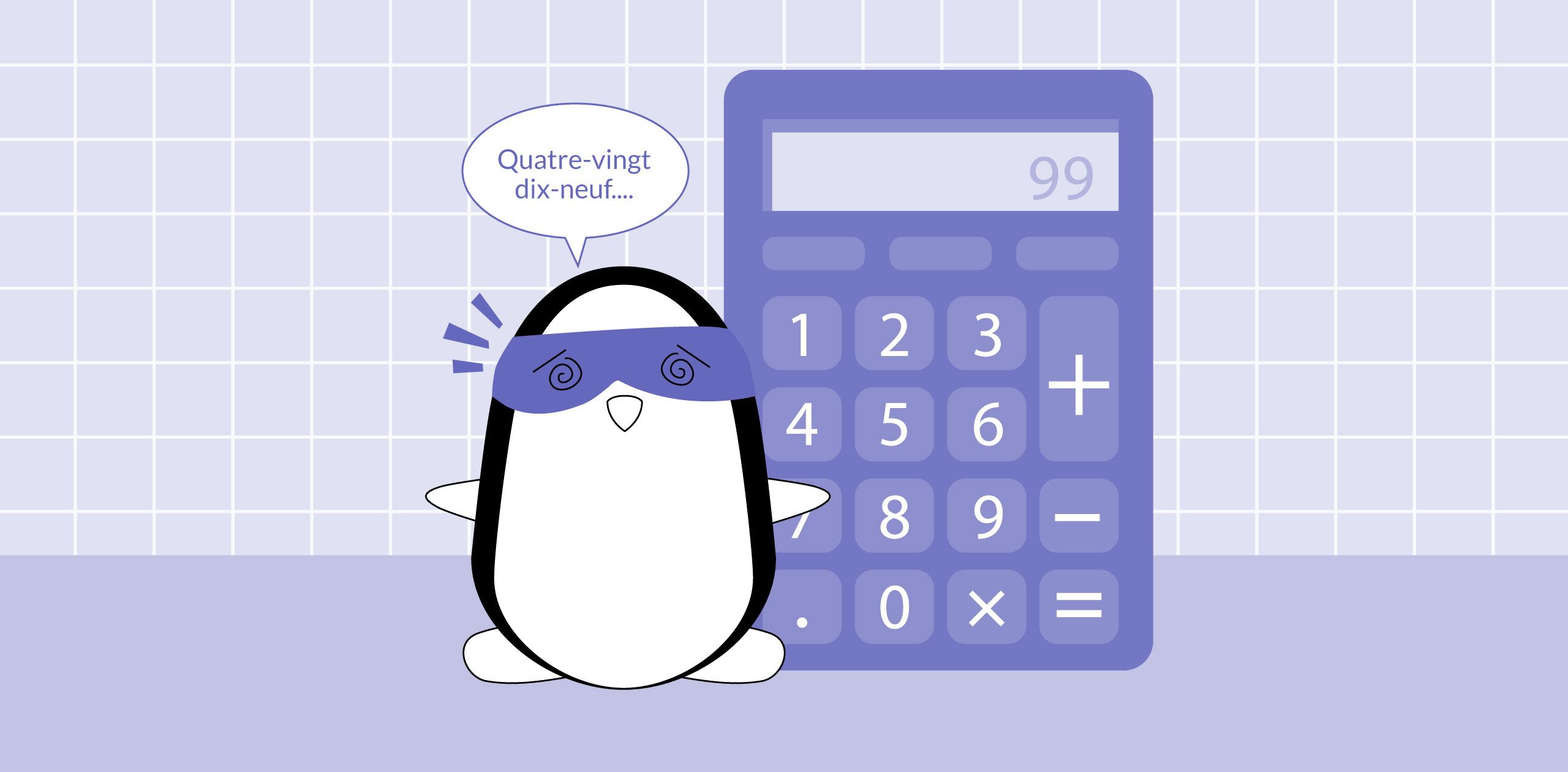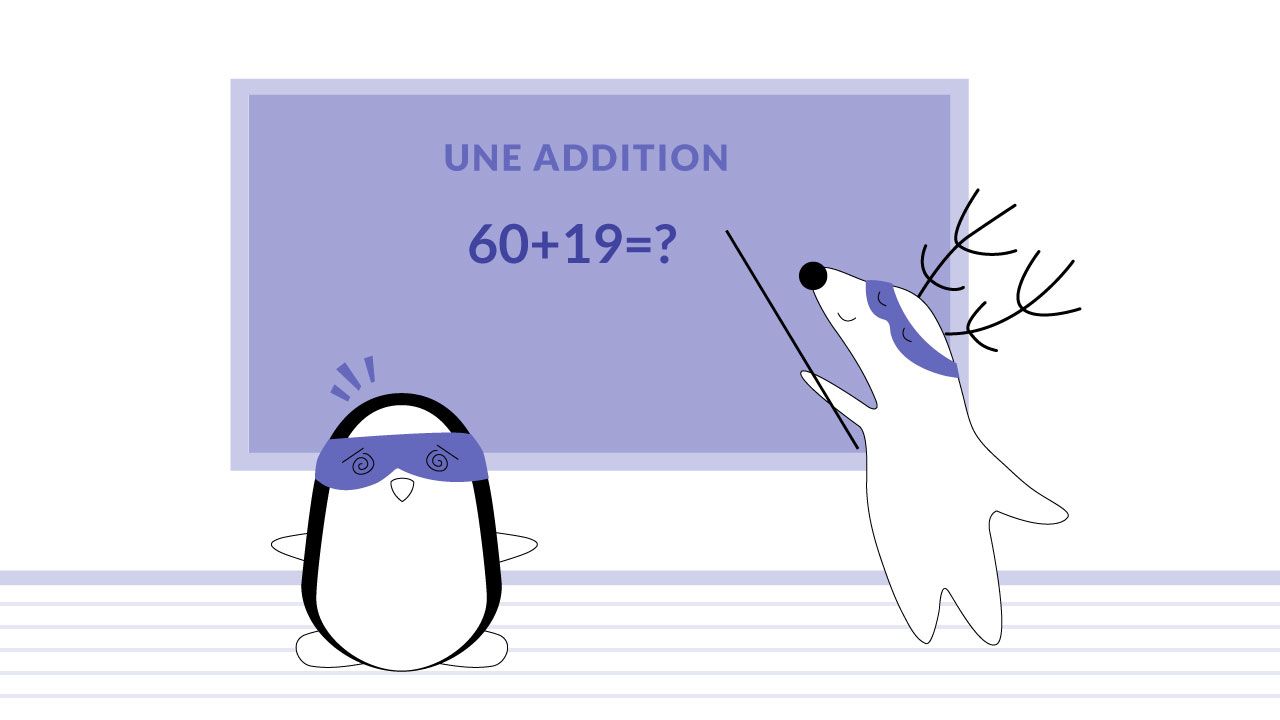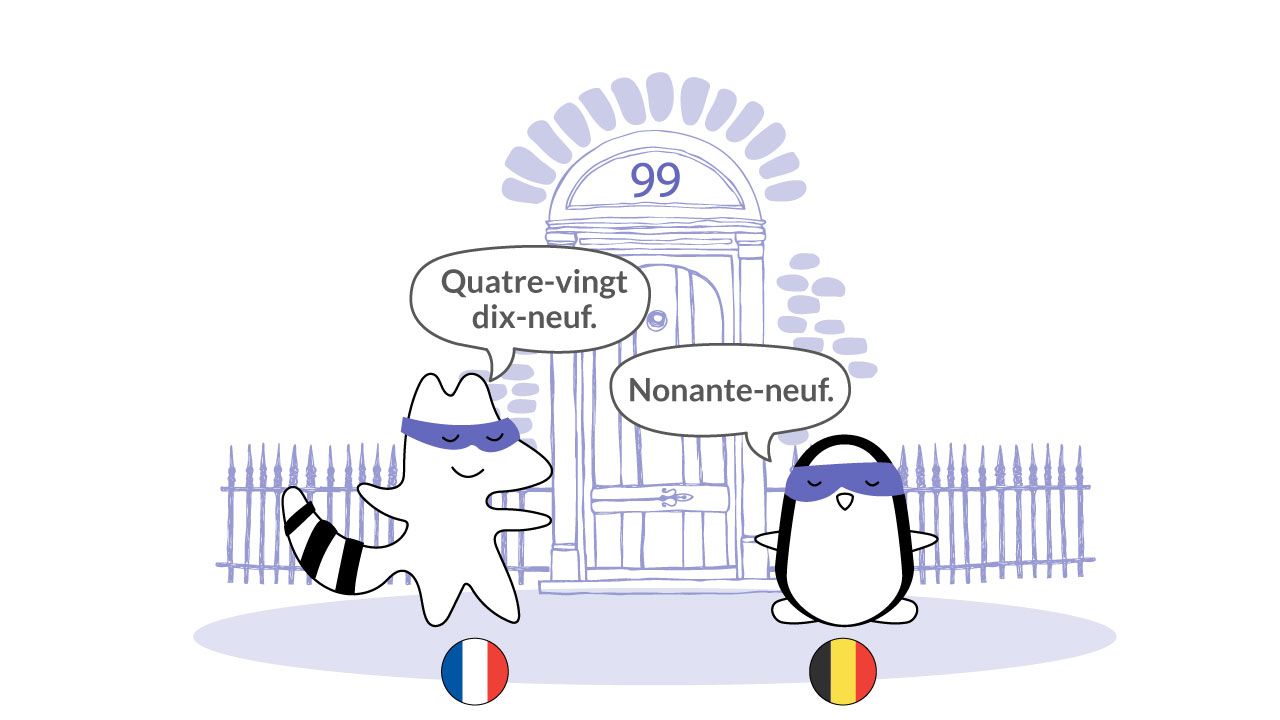
For many beginning language learners, learning French numbers can be quite a headache. This is one of the aspects of learning French that most people complain about - and we French speakers definitely get it. Whether you want to say “seventy-one” or “ninety-nine,” it can be super complicated.
However, French number system is not impossible to learn. It’s especially easy if you learn the basics of how they work. Trust us: there is a rhyme and reason to it. You just need to get the hang of it.
Today, we’re going to help you with that. Let’s take a look at the French numbers from 1 to 100 - and learn how to count in French.
Learn French with Langster
0 to 10

Let’s start with the basics - these are essential, as numbers in French are repeated quite often.
Counting from 0 to 10 is very easy. However, these numbers are not based on any other words, so you will have to memorize them. To memorize these quickly, we strongly recommend using the flashcard method and mnemonic techniques and then reinforcing the knowledge by reading stories in our app.
Here they are:
| 0 | zero |
| 1 | un |
| 2 | deux |
| 3 | trois |
| 4 | quatre |
| 5 | cinq |
| 6 | six |
| 7 | sept |
| 8 | huit |
| 9 | neuf |
| 10 | dix |
| 0 | zero |
| 1 | un |
| 2 | deux |
| 3 | trois |
| 4 | quatre |
| 5 | cinq |
| 6 | six |
| 7 | sept |
| 8 | huit |
| 9 | neuf |
| 10 | dix |
Listen to them to understand how exactly they are pronounced. Don’t worry if you’re unable to say French numbers correctly right away, that skill comes with time and practice.
11 to 19
This is when things start to get a little complicated but don’t worry: all the numbers in this range are based on the basic group. It’s just that some numbers are independent, and some are composed. Confused about independent and composed numbers? Let’s break it down.
Independent numbers are created by adding a -ze suffix to the basic number. To create a composed number, you add a word dix (ten) before the basic number and connect two words with a hyphen. Here they are:
| 11 | onze |
| 12 | douze |
| 13 | treize |
| 14 | quatorze |
| 15 | quinze |
| 16 | seize |
| 17 | dix-sept |
| 18 | dix-huit |
| 19 | dix-neuf |
| 11 | onze |
| 12 | douze |
| 13 | treize |
| 14 | quatorze |
| 15 | quinze |
| 16 | seize |
| 17 | dix-sept |
| 18 | dix-huit |
| 19 | dix-neuf |
As you can see, numbers from 11 to 16 are independent, meaning they have their own word. The numbers 17, 18, and 19 are the first composed numbers you’ll have to deal with. They literally translate to “ten seven,” “ten eight, etc. The numbers 15 and 16 are exceptions here, as they don’t use the basic numbers 5 and 6 as the root - so that’s two more numbers you will have to learn by heart.
20 to 69
This range is not more complicated than the latter one - it just requires a few rules to know.
First, numbers 20, 30, 40, 50, and 60 are independent numbers. They all have the same suffix -te, and they sound similar to their basic numbers. Take a look at them:
| 20 | vingt |
| 30 | trente |
| 40 | quarante |
| 50 | cinquante |
| 60 | soixante |
| 20 | vingt |
| 30 | trente |
| 40 | quarante |
| 50 | cinquante |
| 60 | soixante |
All the other numbers in this range are composed. And while most of them are made just like the ones we talked about above - with a hyphen, there’s an exception. 21/31/41/51/61 are created by using their base, so vingt/trente/quarante/cinquante/soixante, and added et un (and one).
So if you’re counting past twenty in French, it will go, vinght, vinght et un, vinght-deux.
For all the other numbers, you simply connect two basic numbers with a hyphen - for example, trente-trois.
Here’s a table with all the numbers in this range:
| 20 | vingt | 30 | trente | 40 | quarante | 50 | cinquante | 60 | soixante |
| 21 | vingt et un | 31 | trente et un | 41 | quarante et un | 51 | cinquante et un | 61 | soixante et un |
| 22 | vingt-deux | 32 | trente-deux | 42 | quarante-deux | 52 | cinquante-deux | 62 | soixante-deux |
| 23 | vingt-trois | 33 | trente-trois | 43 | quarante-trois | 53 | cinquante-trois | 63 | soixante-trois |
| 24 | vingt-quatre | 34 | trente-quatre | 44 | quarante-quatre | 54 | cinquante-quatre | 64 | soixante-quatre |
| 25 | vingt-cinq | 35 | trente-cinq | 45 | quarante-cinq | 55 | cinquante-cinq | 65 | soixante-cinq |
| 26 | vingt-six | 36 | trente-six | 46 | quarante-six | 56 | cinquante-six | 66 | soixante-six |
| 27 | vingt-sept | 37 | trente-sept | 47 | quarante-sept | 57 | cinquante-sept | 67 | soixante-sept |
| 28 | vingt-huit | 38 | trente-huit | 48 | quarante-huit | 58 | cinquante-huit | 68 | soixante-huit |
| 29 | vingt-neuf | 39 | trente-neuf | 49 | quarante-neuf | 59 | cinquante-neuf | 69 | soixante-neuf |
| 20 | vingt | 30 | trente | 40 | quarante | 50 | cinquante | 60 | soixante |
| 21 | vingt et un | 31 | trente et un | 41 | quarante et un | 51 | cinquante et un | 61 | soixante et un |
| 22 | vingt-deux | 32 | trente-deux | 42 | quarante-deux | 52 | cinquante-deux | 62 | soixante-deux |
| 23 | vingt-trois | 33 | trente-trois | 43 | quarante-trois | 53 | cinquante-trois | 63 | soixante-trois |
| 24 | vingt-quatre | 34 | trente-quatre | 44 | quarante-quatre | 54 | cinquante-quatre | 64 | soixante-quatre |
| 25 | vingt-cinq | 35 | trente-cinq | 45 | quarante-cinq | 55 | cinquante-cinq | 65 | soixante-cinq |
| 26 | vingt-six | 36 | trente-six | 46 | quarante-six | 56 | cinquante-six | 66 | soixante-six |
| 27 | vingt-sept | 37 | trente-sept | 47 | quarante-sept | 57 | cinquante-sept | 67 | soixante-sept |
| 28 | vingt-huit | 38 | trente-huit | 48 | quarante-huit | 58 | cinquante-huit | 68 | soixante-huit |
| 29 | vingt-neuf | 39 | trente-neuf | 49 | quarante-neuf | 59 | cinquante-neuf | 69 | soixante-neuf |
Pronunciation
Of course, pronunciation will also differ a bit in the numbers from different groups. For example, in the word vingt, final consonants are silent, so you will pronounce it as va~.
However, in vingt et un, a liaison occurs, and now the final t will be pronounced - so you will say va~ te a~. Please note that after the et (and) conjunction, liaison never occurs - so there, t still will be silent.
The best thing to learn how to pronounce numbers in French is to listen to the audio below - or download the Langster app.
70 to 79

Now we’re moving to the French numbers that create the most problems for new learners. Don’t worry - even though they may seem complicated, the structure is quite simple.
The one thing you will need here as a base is number 60 - soixante. Then, you simply count by adding numbers from 10 to 19 to it, so as to get the desired number as a sum. Take a look at this list:
| 70 | soixante-dix | (sixty-ten) |
| 71 | soixante-et-onze | (sixty-and-eleven) |
| 72 | soixante-douze | (sixty-twelve) |
| 73 | soixante-treize | (sixty-thirteen) |
| 74 | soixante-quatorze | (sixty-fourteen) |
| 75 | soixante-quinze | (sixty-fifteen) |
| 76 | soixante-seize | (sixty-sixteen) |
| 77 | soixante-dix-sept | (sixty-ten-seven) |
| 78 | soixante-dix-huit | (sixty-ten-eight) |
| 79 | soixante-dix-neuf | (sixty-ten-nine) |
| 70 | soixante-dix | (sixty-ten) |
| 71 | soixante-et-onze | (sixty-and-eleven) |
| 72 | soixante-douze | (sixty-twelve) |
| 73 | soixante-treize | (sixty-thirteen) |
| 74 | soixante-quatorze | (sixty-fourteen) |
| 75 | soixante-quinze | (sixty-fifteen) |
| 76 | soixante-seize | (sixty-sixteen) |
| 77 | soixante-dix-sept | (sixty-ten-seven) |
| 78 | soixante-dix-huit | (sixty-ten-eight) |
| 79 | soixante-dix-neuf | (sixty-ten-nine) |
It does seem challenging, but don’t worry - you will get the hang of it in a short time. Just remember to practice.
80 to 99
Now, here’s where the real trouble begins. Don’t worry, though - there’s a method to this madness. The only thing you need to learn now is that 80 in French is quatre-vingts (four-twenties). Sounds absurd, we know - but that’s how it works, so get used to it. Then, you add the numbers from 1 to 19. And yes, that won’t be completely straightforward.
Here’s a table that will help you learn:
| 80 | quatre-vingts | (four twenties) | 90 | quatre-vingt-dix | (four-twenty-ten) |
| 81 | quatre-vingt-un | (four-twenty-one) (no “et”) | 91 | quatre-vingt-onze | (four-twenty-eleven) |
| 82 | quatre-vingt-deux | (four-twenty-two) | 92 | quatre-vingt-douze | (four-twenty-twelve) |
| 83 | quatre-vingt-trois | (four-twenty-three) | 93 | quatre-vingt-treize | (four-twenty-thirteen) |
| 84 | quatre-vingt-quatre | (four-twenty-four) | 94 | quatre-vingt-quatorze | (four-twenty-fourteen) |
| 85 | quatre-vingt-cinq | (four-twenty-five) | 95 | quatre-vingt-quinze | (four-twenty-fifteen) |
| 86 | quatre-vingt-six | (four-twenty-six) | 96 | quatre-vingt-seize | (four-twenty-sixteen) |
| 87 | quatre-vingt-sept | (four-twenty-seven) | 97 | quatre-vingt-dix-sept | (four-twenty-ten-seven) |
| 88 | quatre-vingt-huit | (four-twenty-eight) | 98 | quatre-vingt-dix-huit | (four-twenty-ten-eight) |
| 89 | quatre-vingt-neuf | (four-twenty-nine) | 99 | quatre-vingt-dix-neuf | (four-twenty-ten-nine) |
| 80 | quatre-vingts | (four twenties) | 90 | quatre-vingt-dix | (four-twenty-ten) |
| 81 | quatre-vingt-un | (four-twenty-one) (no “et”) | 91 | quatre-vingt-onze | (four-twenty-eleven) |
| 82 | quatre-vingt-deux | (four-twenty-two) | 92 | quatre-vingt-douze | (four-twenty-twelve) |
| 83 | quatre-vingt-trois | (four-twenty-three) | 93 | quatre-vingt-treize | (four-twenty-thirteen) |
| 84 | quatre-vingt-quatre | (four-twenty-four) | 94 | quatre-vingt-quatorze | (four-twenty-fourteen) |
| 85 | quatre-vingt-cinq | (four-twenty-five) | 95 | quatre-vingt-quinze | (four-twenty-fifteen) |
| 86 | quatre-vingt-six | (four-twenty-six) | 96 | quatre-vingt-seize | (four-twenty-sixteen) |
| 87 | quatre-vingt-sept | (four-twenty-seven) | 97 | quatre-vingt-dix-sept | (four-twenty-ten-seven) |
| 88 | quatre-vingt-huit | (four-twenty-eight) | 98 | quatre-vingt-dix-huit | (four-twenty-ten-eight) |
| 89 | quatre-vingt-neuf | (four-twenty-nine) | 99 | quatre-vingt-dix-neuf | (four-twenty-ten-nine) |
Another exception that appears in this range is that you don’t put an et conjunction in 81. Also, note that in 80, an s appears at the end of vingt.
What’s Next?

A 100 in French is cent - it’s not based on anything, so that’s another independent number that you will have to learn by heart. If you want to go higher, you simply add a proper number before cent:
| 200 | deux-cents |
| 300 | trois-cents |
| 400 | quatre-cents |
| 500 | cinq-cents |
| 600 | six-cents |
| 700 | sept-cents |
| 800 | huit-cents |
| 900 | neuf-cents |
| 200 | deux-cents |
| 300 | trois-cents |
| 400 | quatre-cents |
| 500 | cinq-cents |
| 600 | six-cents |
| 700 | sept-cents |
| 800 | huit-cents |
| 900 | neuf-cents |
The French word for thousand is mille. Note that when it comes to pronunciation, this is also an exception - ll here has an [l] sound, not [j].
How Counting in French Works
Now that you’ve learned the basics, let’s spice it up a little. If you want to say a complex number in French, you simply add the numbers we’ve listed above together.
For example, for big numbers such as 195, you take the first part - 100 in French - cent, and then add the second part - 95 - quatre-vingt-quinze. Connect everything with hyphens, and there you have it:
French
English
Cent-quatre-vingt-quinze.
One hundred and ninety-five.
French Numbers in Other French-Speaking Countries

When counting in French, most often, you will use the rules we write above. However, not all French speakers follow the same counting patterns.
In Belgium and Switzerland, people don’t say soixante-dix, quatre-vingts, or quatre-vingt-dix. Instead, they have French words for 70, 80, and 90. Here they are:
- 70 - Septante
- 80 - Octante or Huitante (only in Switzerland)
- 90 - Nonante
However, while the French pronunciation of these numbers may feel more natural for a non-native French speaker to use, they aren’t accepted in Parisian French. So if you want to say “ninety-nine,” don’t use nonante-neuf, but a classic version - quatre-vingt-dix-neuf. It will become simple and come easily in some time, don’t worry.
Final Thoughts
We’ve gone over the basic French numbers you might need when learning this language. Not so scary in the end, are they? That’s all about the inner logic and structure - after you get it, everything becomes much less complicated.
Of course, it might take you some time to get used to French numbers - after all, there are some complex combinations, such as quatre-vingt-dix-huit or soixante-et-onze. Nevertheless, after even a few weeks of active learning or a bit of hard work, they should come to you naturally - and you shouldn’t even think much about how to count in French.
Just remember to practice regularly - you need to do it more than just once a month. Sign up for courses or get our app and make sure that you’re consistent at learning French.









